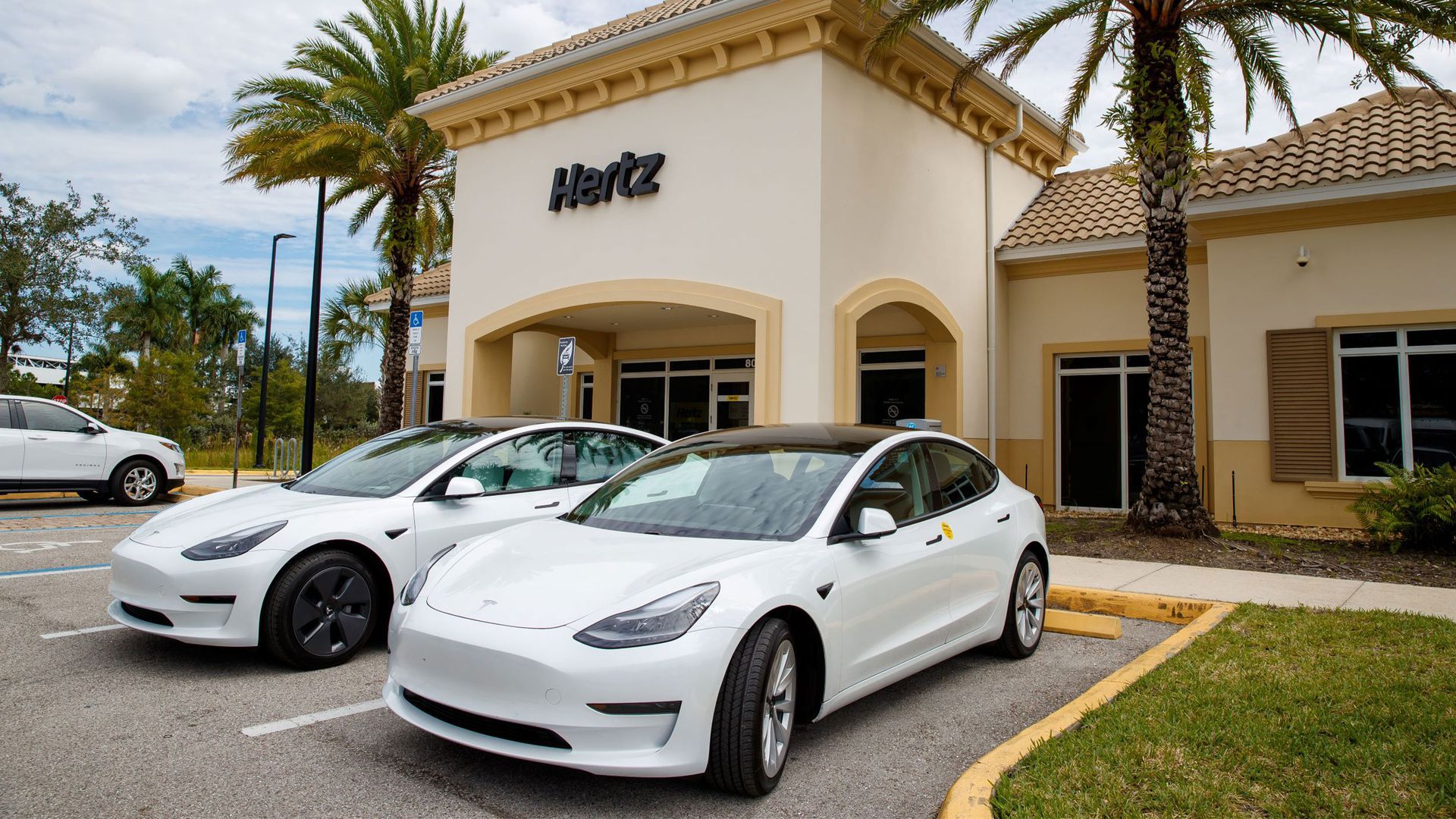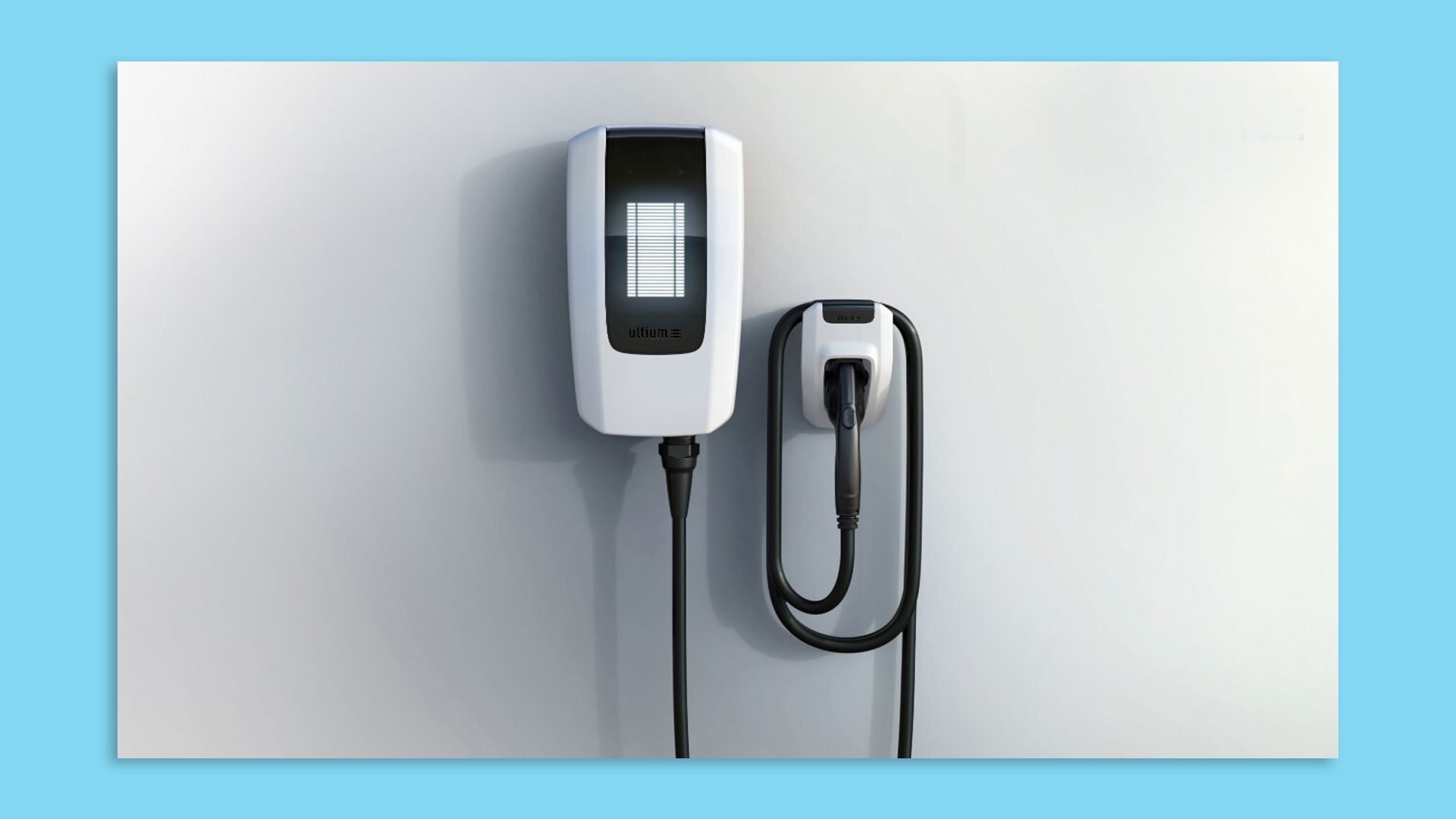| | | | | | | Presented By West Monroe | | | | Axios What's Next | | By Jennifer A. Kingson, Joann Muller and Erica Pandey ·Oct 27, 2021 | | This just in: Uber announced this morning that it's placing its first big bet on EVs, as Joann Muller reports. 💼 Please join Erica Pandey today at 12:30pm ET for a half-hour virtual event on what's next for career readiness. Register here. - Today's reader photo comes from Emily Baskis, who discovered that bikes aren't the only transport you can rent from an automated kiosk.
- Keep your anecdotes and photos depicting "what's next" coming to whatsnext@axios.com.
Today's Smart Brevity count: 1,233 words ... 4.5 minutes. | | | | | | 1 big thing: A big EV push for Uber drivers |  | | | Uber drivers will be able to rent Tesla EVs from Hertz starting in November. Photo: Hertz | | | | Half of the 100,000 Teslas that Hertz is adding to its rental fleet will be reserved for Uber drivers, many of whom can't afford to buy an electric car of their own, Joann writes. Why it matters: Uber in 2020 pledged to convert its entire ride-hailing fleet in the U.S., Canada and Europe to electric by 2030. But doing so means convincing gig drivers to invest in a new — and likely more expensive — vehicle. - The deal with Hertz is a more affordable option for drivers, Uber says.
Catch up fast: Hertz made a splash Monday by announcing it will purchase 100,000 Tesla Model 3s by the end of 2o22. What's new: The deal turns out to have huge implications for Uber and its green commitment, as the arrangement between Hertz and Uber makes clear. - Hertz is setting aside up to 50,000 Teslas exclusively for rent by Uber drivers, the companies said.
- Uber called it a "win-win" for drivers who rent their car: a chance to both increase their take-home pay and reduce their environmental impact.
Because ride-share vehicles tend to rack up more miles than the average car, they're more harmful to the environment. - When ride-share drivers go electric, their carbon emissions savings is three to four times greater than an average car owner, according to Uber.
Details: Starting Nov. 1, Uber drivers will be able to rent a Tesla from Hertz in Los Angeles, San Francisco, San Diego or Washington, D.C., with other cities to follow. - Uber expects to have "a couple thousand" rented Teslas on its network by the end of the year, scaling to 50,000 by 2023.
- The rentals will start at $334 a week, then fall to $299 or lower as the program gets underway, an Uber spokeswoman said. The rental fee includes insurance and maintenance.
The cost will be comparable to renting a gasoline vehicle, Uber says, because of the incentives drivers will earn to make the switch to an EV. - EV drivers will get an extra $1 for every trip up to $4,000 annually, for example, and can earn more when riders choose Uber's slightly more expensive "Green" or "Comfort" options, the company said.
There are other reasons for Uber drivers to go electric. EV maintenance costs are lower because they have fewer parts and don't need oil changes. - The regenerative braking systems of EVs last longer than ordinary brakes.
- With a range of 262 miles to 353 miles — depending on their Tesla's battery size — ride-hail drivers should have plenty of juice to complete a shift.
Read the full story. |     | | | | | | 2. The lingering legacy-admissions racket |  | | | Illustration: Aïda Amer/Axios | | | | Legacy admissions — in which universities favor applicants directly related to a school alumnus or alumna — are one of the most blatant and unapologetic ways that rich white families receive privileged access to elite institutions, in the view of Axios Capital author Felix Salmon. Why it matters: Legacy admissions are slowly going away, but there's a very good reason they still remain: They're a way to admit more students from wealthy families, who in turn are more likely to become big donors. Driving the news: Amherst College said last week that it would no longer grant preference to the children of alumni, thereby joining such institutions as the University of California, MIT and Pomona College. By the numbers: The effects of legacy admissions can be startling. - At Notre Dame, legacies outnumber Black students by a factor of 5 to 1.
- At Harvard, 77% of legacy students are white, and less than 6% of legacy admission offers go to Hispanic students.
How it (doesn't) work: Legacy-admissions policies don't increase the amount of giving that any student or family will end up donating. - A 2008 paper found that donations actually tended to rise after legacy admissions were abolished.
- A 2010 study concluded that "there is no statistically significant evidence of a causal relationship between legacy preference policies and total alumni giving among top universities."
The bottom line: Children of the rich will always find it easier to get in to any given university, even without legacy preferences, than will immigrants, the poor or students whose parents never went to college. - They will also, statistically speaking, end up donating more after they've graduated. Which is one reason why colleges continue to give those students an extra advantage.
Read the full story. |     | | | | | | 3. Facebook wants younger friends |  Data: Piper Sandler Taking Stock With Teens Study; Chart: Axios Visuals Facebook is pivoting its strategy to focus on young adults, following reports that teens have fled its apps, Axios Media Trends author Sara Fischer writes. Why it matters: A series of stories based on leaked whistleblower documents suggest the company sees the aging of its user base as an existential threat to its business. - Not only are younger users — especially those in the U.S. — a coveted demographic for advertisers, they're also key to Facebook's long-term growth trajectory.
What they're saying: On an earnings call with investors, CEO Mark Zuckerberg said Facebook will be "retooling" its team to make "serving the young adults their north star, rather than optimizing for the larger number of older people." Between the lines: Third-party data has long suggested that Facebook was losing ground with teens, particularly on its main app, but Facebook's announcement suggests the company is starting to feel the competitive pressure from rivals. - Instagram is Facebook's most youth-oriented service. But data from Piper Sandler's most recent survey on teens shows that Instagram continues to lose ground to Snapchat and TikTok.
- Zuckerberg called TikTok "one of the most effective competitors that we have ever faced."
- To boost youth engagement, Facebook has adopted new features that mimic rival apps. Last summer, Facebook launched its TikTok rival, called "Reels," on Instagram.
What to watch: The shift to lure back young adults, Zuckerberg says, "will take years, not months." Read the full story. |     | | | | | | A message from West Monroe | | The real differences between traditional and digital operations | | |  | | | | Everyone says "digital" but means different things. Our take? Digital companies operate differently. They are: - Algorithmic, not manual.
- Data-driven, not managed by feeling.
- Human-centered, not system-centered.
Those are three characteristics of digital operations. Here are the rest. | | | | | | 4. GM's plan to end EV charging deserts |  | | | GM is rolling out a line of Ultium-branded EV chargers for home and commercial use. Photo: GM | | | | General Motors will work with its dealers to fill gaps in America's electric vehicle charging infrastructure, including installing new charging stations in underserved urban and rural areas, Joann Muller writes. Why it matters: People aren't likely to buy electric vehicles unless it is convenient to charge them at home, at work or on road trips. Driving the news: GM President Mark Reuss announced the dealer community charging program Tuesday at an event sponsored by the U.S. Travel Association to explore the changing ways people will travel in the future. - The initiative, which kicks off in 2022, is part of GM's $750 million commitment to EV charging infrastructure, announced this month.
Details: With help from its dealers, GM aims to spur the installation of 40,000 electric vehicle chargers across the U.S. and Canada. - The company will give each of its 4,500 dealers up to 10 of its Level 2 Ultium-branded chargers to install throughout their communities.
- While GM will supply the equipment, the dealers will pay for the installations, GM said.
Where it stands: Unlike Tesla, which has a proprietary supercharger network (and Volkswagen, which plans a network of its own), GM expects its EV owners will tap into a variety of public charging networks. Read the full story. |     | | | | | | 5. Reader photo of the day |  | | | An automated kayak rental kiosk. Photo: Emily Baskis | | | | Emily Baskis writes: "I've attached a photo of a self-service kayak [rental] station. "I live and work in Manhattan, but this past week I've been visiting my family at their home outside Leander, Texas. I was so surprised to see that the kayak stand at a nearby lake had replaced its workers with this station. Like my grandma always used to say … the times they are a-changin'!" |     | | | | | | A message from West Monroe | | Leading companies treat digital as a mindset, not a project | | |  | | | | Bottom line? Digital transformation projects fail. Your business either has a digital mindset, or it doesn't, so: - Treat digital as a team sport.
- Solve business challenges, not technical needs.
- Organize around the customer and never stop adapting.
Learn how to become a digital business. | | | | Was this email forwarded to you? Get the daily dose of What's Next magic by signing up for our free newsletter here. |  | | It'll help you deliver employee communications more effectively. | | | | | | Axios thanks our partners for supporting our newsletters. If you're interested in advertising, learn more here.
Sponsorship has no influence on editorial content. Axios, 3100 Clarendon Blvd, Suite 1300, Arlington VA 22201 | | | You received this email because you signed up for newsletters from Axios.
Change your preferences or unsubscribe here. | | | Was this email forwarded to you?
Sign up now to get Axios in your inbox. | | | | Follow Axios on social media:    | | | | | |









No comments:
Post a Comment